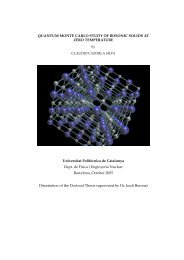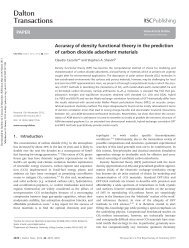Journal of Low Temperature Physics 171, 619 - DR. CLAUDIO ...
Journal of Low Temperature Physics 171, 619 - DR. CLAUDIO ...
Journal of Low Temperature Physics 171, 619 - DR. CLAUDIO ...
Create successful ePaper yourself
Turn your PDF publications into a flip-book with our unique Google optimized e-Paper software.
J<strong>Low</strong>TempPhys<br />
Fig. 2 Pair distribution<br />
functions on the xy plane for<br />
different structures on<br />
B-graphane. The blue line<br />
represents the liquid phase at a<br />
density <strong>of</strong> 0.0740 Å −2 and the<br />
purple one, the new<br />
commensurate structure<br />
observed to be stable on<br />
B-graphane at a density <strong>of</strong><br />
0.0921 Å −2 (Color figure<br />
online)<br />
In the case <strong>of</strong> H 2 adsorbed on W-graphane, the δ phase is not stable. This means<br />
that the phase transition goes directly from a √ 3 × √ 3 phase to a triangular incommensurate<br />
solid. In Fig. 4 we represent the pair distribution function for the stable<br />
triangular incommensurate phase at a density <strong>of</strong> 0.0843 Å −2 and the corresponding<br />
ones for δ and liquid phases at similar densities. From this figure, we can see that<br />
even the solid structures (the stable triangular phase and the unstable δ solid) are more<br />
isotropic than the commensurate structure already described for the B-graphane. This<br />
is probably due to their smaller density in comparison to the one in the B-graphene.<br />
This increases the average distances between first (and successive) neighbors and<br />
blurs the differences between them to merge the maxima in the pair correlation functions.<br />
4 Conclusions<br />
We presented the zero-temperature H 2 phase diagrams on three types <strong>of</strong> graphane.<br />
In all cases, the ground state is the √ 3 × √ 3 commensurate solid, the similar result<br />
than the obtained for graphene [7]. From this structure, one or several phase transitions<br />
takes the system to a stable triangular incommensurate solid if the density<br />
increases enough. For W-graphane, the transition is direct. However, for C-graphane<br />
and B-graphane there are intermediate stable structures. In the case <strong>of</strong> C-graphane,<br />
the intermediate arrangement is a δ phase, a commensurate solid similar to the found<br />
for D 2 graphene and graphite [8]. On B-graphane, the phase transition goes first to<br />
the δ commensurate phase and later to an another commensurate structure.





